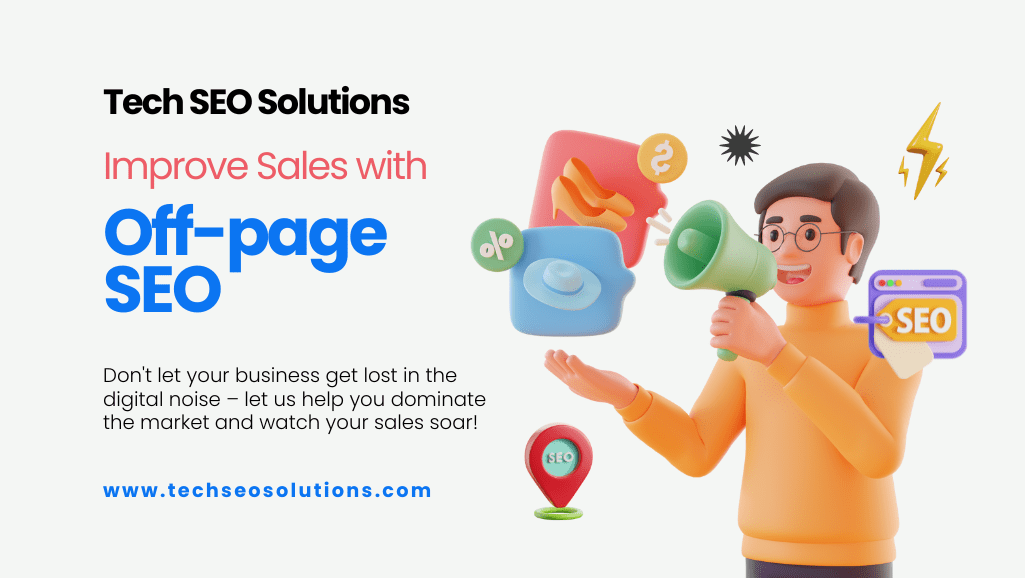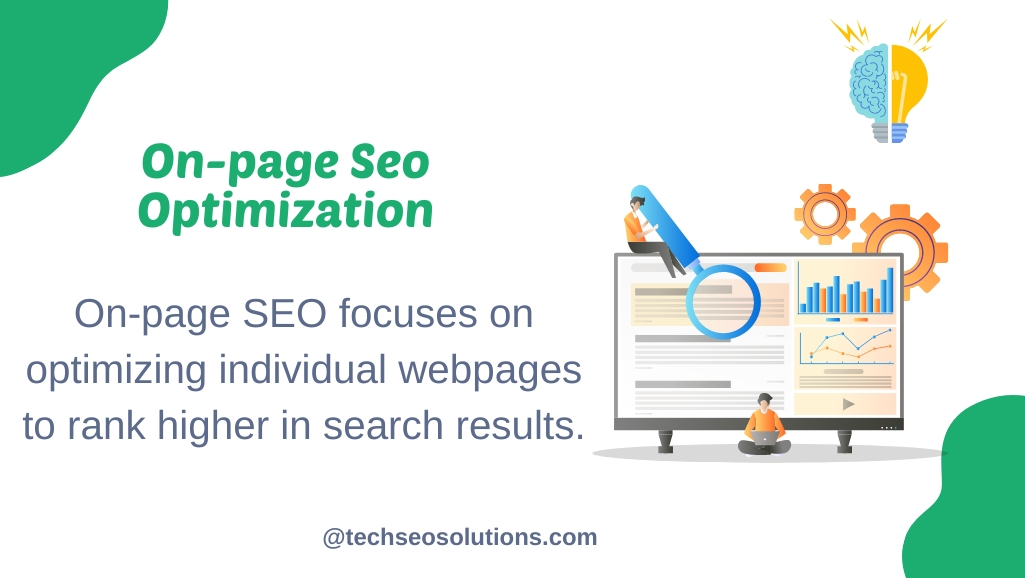Off-page SEO encompasses all activities conducted outside your website to boost its search engine rankings. Key off-page SEO strategies include building high-quality backlinks, promoting branded searches, and enhancing social media engagement and shares.
Simply put, off-page SEO involves external efforts to make your site appear credible and authoritative to Google and other search engines.
In this guide, I’ll dive into what off-page SEO entails and its significance in 2024.
Additionally, you’ll discover the key differences between off-page SEO and on-page SEO. Let’s start!
Table of Contents
Why Is Off-Page SEO Important?
Backlinks and other off-site signals remain crucial to Google’s algorithm.
A study on search engine ranking factors revealed a strong correlation between total backlinks and Google rankings.
Moreover, Google has confirmed that they still utilize PageRank.
However, links are just one aspect of off-page SEO. Google also relies on various other off-site signals to evaluate your website.
For instance, Google’s Quality Rater Guidelines emphasize a site’s off-site reputation to determine its trustworthiness, a process known as “Reputation Research.”
“Reputation Research” involves assessing online reviews
Recommendations from experts
And mentions on authoritative news sites and Wikipedia.
The bottom line? While links are the most significant off-page SEO signal, they are just one of many.
In the rest of this guide, I’ll cover links and other essential off-site factors you need to know.
How to Boost Your Off-Page SEO With Backlinks?
When it comes to off-page SEO, backlinks are incredibly important.
However, effective backlink building focuses on quality over quantity.
To improve your rankings in the SERPs, the links you acquire must be authoritative and come from relevant sites.
Here, we’ll explore four effective strategies for building high-quality authoritative links that are delivering excellent results right now.
Become a Valuable Resource
Let’s look at a prime example from one of the industry leaders, “Backlinko.”
During some casual research, I noticed something fascinating.
The majority of links to that particular page came from articles covering statistics, and they cited the specific Backlinko article for its data.
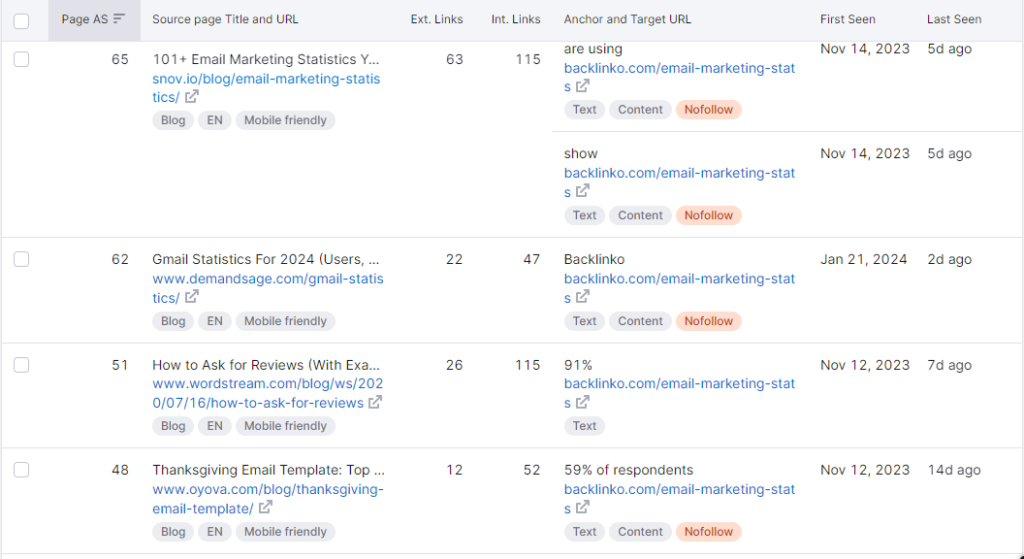
In essence, people weren’t linking to the page because it was just high-quality content.
They linked to cite specific stats.
That’s when it struck me: What if I added more statistics to my site? Would that naturally attract more backlinks?
So, I decided to test this hypothesis.
I invested significant time and resources into creating an extensive list of ”facebook audience stats and facts”.
I did this for one of my clients to attract backlinks naturally. Then, I optimized it for a keyword that bloggers and marketers frequently search for when researching (“facebook audience stats”).
Sure enough, within a few weeks, the page started to appear on the first page of search results.
And just a few days later, I received my first backlink 🙂
Broken Content Building
This is a twist on traditional Broken Link Building.
Typically, Broken Link Building campaigns involve finding broken links pointing to specific pages.
The challenge is that locating broken pages in your niche can be quite difficult.
Here comes a new technique, Broken Content Linking.
With Broken Content Linking, you use Semrush Site Audit as a broken link search engine.
Then, you apply traditional Broken Link Building strategies to build links to your site.
For example, I published a comprehensive email marketing guide some time ago.
To find opportunities, I simply enter “email marketing” into the Content Explorer in Ahrefs.
Next, I filter for “Only Broken” pages.
This reveals popular content that is now dead.
Just like that, I discovered dozens of pages I can target for Broken Link Building.
Double Down On Long-Form Content
Will publishing long-form content automatically attract links? No. However, it can significantly boost the likelihood of others linking to your site.
In fact, a study found that long-form content receives 77% more links than shorter posts.
Strategic Guest Posting
Guest blogging enhances your off-page SEO in several ways. First, guest posts expose your brand to a completely new audience.
Second, guest posts can result in unlinked brand mentions. Unlinked mentions aren’t as powerful as backlinks, but they still provide value.
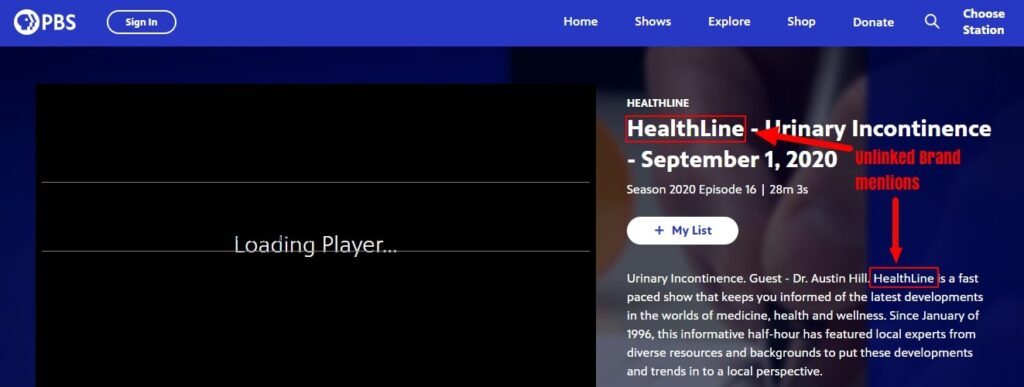
Finally, you can acquire backlinks from your guest posts.
Build links with guest posts
In my experience, guest post backlinks do improve your rankings.
The only thing is that this strategy is most effective when you publish guest posts on sites within your industry.
To clarify: these sites don’t need to be in your exact niche.
For example, I published a guest post on the Buffer blog.
Most of Buffer’s content is about social media, while Tech SEO Solutions focuses on SEO.
But they’re closely related enough to work.
Generate Brand Signals
Now, let’s delve into a highly underrated aspect of off-page SEO:
Brand Signals.
Brand Signals are what Google relies on to determine the legitimacy of your site as a brand.
Or as famously stated by Google’s Eric Schmidt: “Brands are the solution, not the problem… Brands are how you sort out the cesspool”.
Audit Your Branded Searches
Branded searches represent the number of individuals who search for your brand on Google.
These searches may include your exact brand name (e.g., “tech seo solutions”) or your brand name combined with a specific word or phrase (e.g., “tech seo solutions packages”).
You can conveniently access this information through the Google Search Console Performance Report.
Invest in YouTube
YouTube marketing stands out as a top method for enhancing your site’s Brand Signals.
(Especially through branded searches.)
Why is that?
Two key reasons:
Firstly, your videos have the potential to reach a large audience.
This results in increased discussion, coverage, and mentions of my brand online.
Additionally, having authentic and popular social media accounts can serve as a Brand Signal in its own right.
Secondly, many individuals who view your videos will subsequently search for your brand on Google.
This is because YouTube doesn’t facilitate easy website visits directly from its platform.
In some respects, this might be disappointing.
However, the upside is that a successful video can trigger a surge of branded searches.
Set Up Brand Tracking
This method provides a simple means to monitor the frequency of discussions about your brand across news sites, blogs, and forums, allowing you to track changes in this pattern over time.
Numerous excellent brand tracking tools are available (such as Mention.com). Personally, I utilize BuzzSumo’s “Alerts” feature.
You can even assess whether brand mentions have been increasing or decreasing over the past year.
Publish Research-Backed Content
Content backed by research can significantly benefit your off-page SEO efforts by attracting high-quality backlinks.
Additionally, it tends to generate a considerable number of shares on social media platforms.
Do I believe that Google considers “social signals” in its ranking algorithms? No.
Google has explicitly stated that social signals do not directly impact rankings.
Moreover, they are susceptible to manipulation. Anyone can purchase 1000’s of Facebook likes from platforms like Fiverr.
However, social sharing can indirectly contribute to your off-page SEO success.
This is because increased social shares expose your brand to a wider audience, potentially resulting in more branded searches and mentions.
Improve E-E-A-T
E-E-A-T (Experience, Expertise, Authoritativeness and Trustworthiness) has emerged as a crucial off-page SEO ranking factor.
This is particularly true in the health niche.
Contrary to popular belief, enhancing E-E-A-T involves much more than simply adding author bios to your site.
This is because Google primarily assesses E-E-A-T based on signals originating from sources external to your website.
Therefore, if you aim to enhance your site’s E-E-A-T, this chapter is essential for you.
Get Brand Mentions on Authority Sites
According to Google’s Gary Illyes, both links and mentions play a role in determining a site’s E-E-A-T.
While links are generally more impactful, an unlinked mention on a reputable site can still be valuable.
An unlinked mention from a major website like Forbes, even if it’s outside your niche, is likely to positively contribute to your off-page SEO efforts, despite the lack of a direct link.
Acquire Backlinks From Authority Websites in Your Niche
It turns out that Google still relies on traditional PageRank to establish E-E-A-T.
Google utilizes PageRank for E-E-A-T determination.
However, they don’t solely consider a site’s overall Domain Authority.
A Google patent from 2018 outlines a system where greater weight is given to links originating from relevant authority websites in your niche.
In simpler terms:
While obtaining links from authoritative sites like the NY Times is beneficial, receiving links from sites linked to by the NY Times can also enhance your E-E-A-T.
Get a Positive Reputation Online
Google’s Quality Rater guidelines place significant importance on online reviews.
This aligns with logic: if your business receives negative feedback, why would Google prioritize displaying your site to more users?
For local businesses, the impact of reviews on local SEO is well-known.
Interestingly, reviews also influence your site’s E-E-A-T in Google’s assessment.
If your business doesn’t involve customer reviews (such as a blog or media site), Google considers factors like awards you’ve received:
Additionally, Google takes into account the opinions of experts in your field regarding your website:
For instance, Semrush recognizes Backlinko as the #4 SEO blog.
From a conventional SEO perspective, this post primarily provides a backlink.
However, it’s evident that Google likely utilizes awards like this to evaluate the E-E-A-T of Backlinko.
Content Syndication
Content syndication involves the redistribution of content across one or more websites. Some websites opt for syndication as it offers an alternative to constantly generating fresh content, while also providing exposure to a new audience.
Popular content syndication platforms include Medium, LinkedIn, Outbrain, Taboola, Vocal, Business 2 Community, and Quuu.
Alternatively, you can identify websites within your niche and propose syndication partnerships with them.
However, it’s essential to approach content syndication cautiously. Google states that it will prioritize displaying the version of content deemed most suitable for users in search results, which may not always be the version preferred by the original publisher.
To mitigate the risk of syndicated content outranking the original, ensure that syndicated pieces include links back to the original source.
Additionally, properly configuring canonical tags by adding HTML code to your site can indicate the primary version of a page and help maintain its search ranking authority.
Doing Local SEO of Your Website
Local SEO involves optimizing your online presence to boost traffic, visibility, and brand recognition within your business’s local vicinity.
Here are two essential off-page SEO techniques for local businesses:
1. Google Business Profile Management:
Managing your Google Business Profile (GBP) is crucial for influencing how your business appears in Google search results. Optimizing your GBP is a vital off-page SEO strategy and a critical factor for local SEO rankings.
A well-optimized GBP can enhance your site’s visibility in prominent positions on Google’s search results pages, such as the map pack.
Here’s an example of the Google Business Profile of GOOGLE 🙂
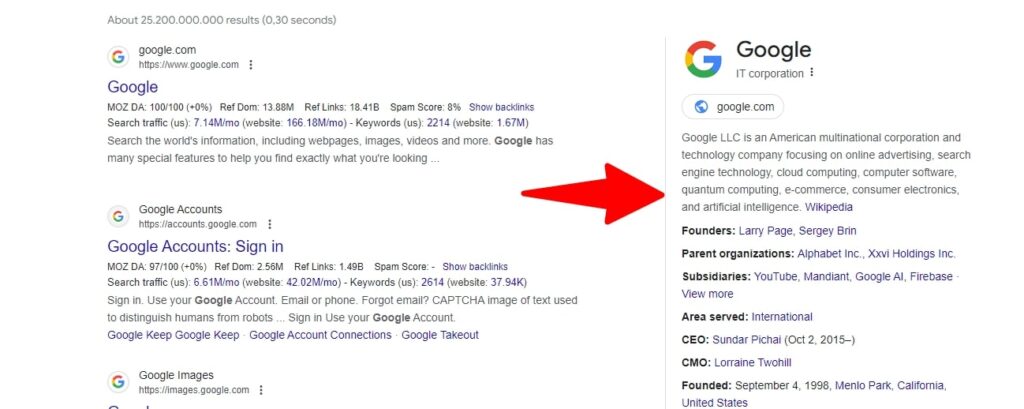
Ensure excellent attention to detail in your contact information, promptly respond to all reviews, and regularly publish posts, including photos and videos, to maximize your GBP’s effectiveness.
2. NAP SEO (Name, Address, Phone Number):
NAP SEO focuses on ensuring the accuracy of your business’s name, address, and phone number (NAP) across online listings, including business directories, social media profiles, and review sites.
Consistent NAP citations are essential as Google utilizes them to verify your business information.
Inconsistencies in citations can lead to confusion for both users and search engines.
Utilize tools like the Listing Management tool to streamline the process of maintaining consistent NAP references.
Additionally, submit your business information to niche and local websites and conduct monthly NAP audits to uphold consistency across all platforms.
What Are Some Bonus Off-Page SEO Techniques?
Now, let’s move on to a compilation of highly practical off-page SEO strategies.
If you’re prepared to implement the concepts we’ve discussed thus far, you’ll find this section invaluable.
Let’s get started without delay.
Press Release Distribution
Sending a press release can directly result in brand mentions and backlinks.
(Of course, having newsworthy content to share is essential)
In the press release itself, you’ll naturally receive a brand mention and a link.
However, what’s more significant is that several sites will discover your website through the press release, ultimately leading to additional links and brand mentions.
Actively Participate In Roundup Posts and Go For Interviews
Roundup posts serve as an effortless method to acquire links and mentions, particularly when compared to traditional guest posting.
These posts typically feature contributions or quotes from multiple experts within a niche. When participating in a roundup, individuals have the opportunity to share their insights or expertise, often accompanied by a link back to their website or brand.
Additionally, being featured in a roundup can result in a mention of the individual’s brand, further enhancing visibility and credibility within the industry.
Interviews, whether on podcasts or other websites, present an often overlooked off-page SEO strategy. Being interviewed by authoritative sites or influential personalities can significantly enhance brand visibility and credibility in the eyes of Google.
Even if the interview itself doesn’t result in a direct link, the exposure gained can lead to increased brand searches, indirectly benefiting SEO efforts.
Therefore, interviews serve as a valuable means of acquiring backlinks and bolstering overall brand presence in the online landscape.
Overall, roundups provide a relatively simple yet effective means of generating backlinks and increasing brand recognition within relevant communities.
Partner With Bigger Brands
You might assume that larger brands have little interest in engaging with small business owners like ourselves.
However, that assumption is incorrect.
If you can offer genuine value to a larger brand, they are often willing to share your content and direct traffic to your site.
Create Visuals That Other Blogs Can Use
Visual content presents a fantastic opportunity to garner mentions from other blogs, reducing the need for extensive blogger outreach efforts.
The visuals prove to be helpful for readers, who are unfamiliar with the topic.
Consequently, many other bloggers will also incorporate your visual into their posts, often linking back to your site as the original source.
In my experience, most individuals who use your image in their content will include a link to your site. Even if they don’t, you still receive an unlinked brand mention, which can provide a modest boost to your off-page SEO efforts.
Influencer Marketing
Influencer marketing entails collaborating with popular bloggers and social media personalities to endorse your products or services. This strategy is highly effective for brand building, content amplification, and reaching new target audiences.
Influencers boast significant followings and can ensure your brand maintains a strong presence across relevant platforms.
A convenient method for identifying influencers is through the use of the Influencer Analytics app.
This tool allows you to search for influencers on various platforms, such as YouTube.
By applying filters based on factors like subscriber count, category, and budget, you can pinpoint influencers who align best with your brand’s objectives.
Once you’ve identified potential influencers, you can assess their engagement metrics and contact information to facilitate outreach efforts.
Why does off-page SEO matter?
In this world of the Internet, standing out is the first step to catching the public eye. Whether it’s popping up in Google search results or getting a nod(Backlink) from another website or social profile, both search engines and people rely on links and mentions to find content. These pathways are incredibly important.
Imagine someone searching for “best headphones for 5 years old.”
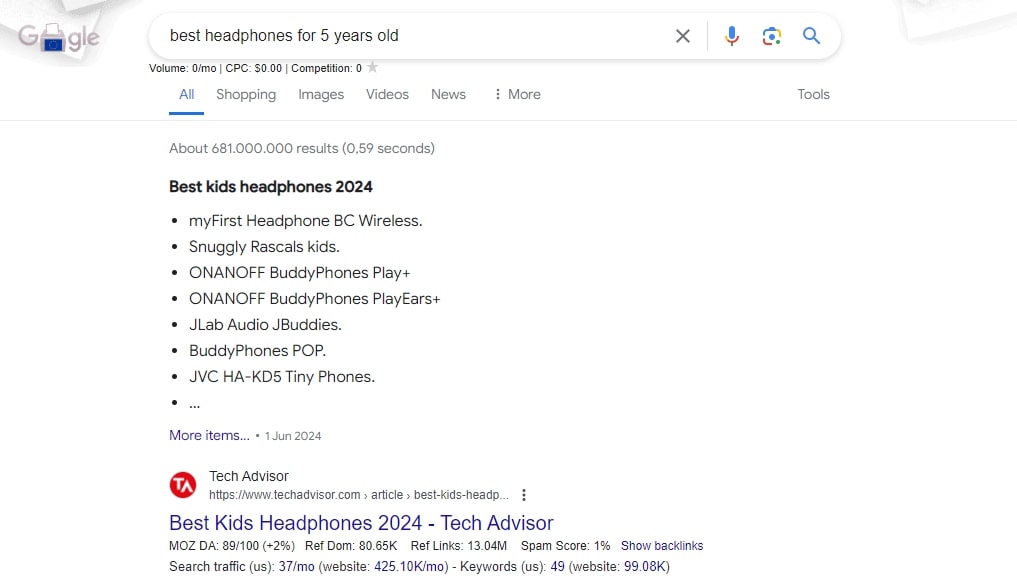
Search engines like Google and Bing have the tough job of figuring out which results will best match what the searcher is looking for.
One of the ways they do this is by checking how many other trustworthy and relevant sources have linked to or mentioned each piece of content.
If you’re utilizing SEO tools such as Ahrefs, Semrush, or Chrome extensions like Moz, you can assess a website’s domain authority (DA), providing insight into its overall authority. The higher the score, the greater the authority, resulting in significant benefits for rankings.
You can also do this for individual pages to estimate their page authority (PA). While search engine algorithms are top-secret, Google’s Search Quality Rater Guidelines give us some pretty good clues about what they think makes a website or piece of content high quality.
SEO experts pay close attention to updates in these algorithms and run their own experiments to learn more.
And what they’ve found is that links and mentions are key factors in how well content performs in search results and how users interact with it.
For instance, let’s say you search for “top car engine oils” and find a top result. Chances are, that result has gotten a lot of links and mentions from other websites.
When you click through to that site, you might notice something interesting.
They’re not just hoarding all their authority for themselves. Nope, they’re sharing the love by linking out to other relevant resources.
Take, for example, a link from a respected site like HomesandGardens.com to a local nursery.
That link doesn’t just boost the nursery’s chances of showing up in search results—it also introduces potential customers to the nursery’s website.
That’s the beauty of off-page SEO—using links and mentions from other sites to boost your own visibility and connect with your audience.
Let’s dive into more examples to see how it all comes together.
When Should I Start Link Building For a Website or Page?
Links remain crucial to Google’s ranking algorithm. Without links pointing to a web page, Google finds it challenging to assess its value, regardless of its usefulness, freshness, or depth of content.
Many site owners may overlook initial preparations for link building, but prioritizing this step is essential. Properly preparing a site ensures careful consideration of the links directed to it.
So, how can you guarantee that your web pages are primed for effective link building? Or In other words, when should you start your link building campaign? Here’s how!
Make Sure Your Internal Pages Are Well-Optimized
Optimizing internal pages can significantly impact your overall rankings. This involves strategically interlinking pages using relevant keywords, with a focus on your brand name.
Brian Dean’s acclaimed post, “Google’s 200 Ranking Factors,” underscores the significance of internal linking by emphasizing a page’s relevance in comparison to others on the site. The higher the number of internal links pointing to that specific page, the more importance Google attributes to it.
However, caution is advised. According to a recent study by Semrush, 42.5% of websites have broken internal links.
To optimize internal linking, consider implementing silo pages that connect category pages and supporting posts. This ensures that link juice flows through your site, enhancing search performance.
Effective SEO professionals don’t merely scatter links across pages. Instead, they structure pages to facilitate the flow of SEO juice to interconnected pages.
Each internal page should be an integral part of your site with seamless navigation, catering to both users and search engines.
Linking related topic pages together improves user experience and SEO value. Many overlook the significance of internal pages in SEO, yet much of a site’s SEO value stems from the site structure.
Properly siloing pages fosters healthy link equity among internal pages. Remember, link quality is just as crucial as page structure.
Sometimes, reducing the number of links to internal pages can benefit SEO efforts.
Start With Basic On-page SEO
On-page search engine optimization (SEO) is crucial. Neglecting it can lead Google to perceive your site as neglected and lower its ranking.
While title ,meta description and keyword density are well-known aspects, other critical on-page SEO factors are often overlooked.
Many authoritative sites have lost their dominance in organic listings due to neglecting basic on-page SEO.
It’s essential to link to internal pages using relevant keywords that accurately define the page’s content.
When aiming for a high ranking for a landing page, prioritize passing more SEO authority from important pages to that specific page.
If Google sees multiple pages on your site competing for the same search term without clarity on which to rank higher, your ranking will suffer despite your content’s value.
The fundamental on-page SEO process revolves around structuring pages effectively, optimizing keywords, and sending signals to Google appropriately, all contributing to improving search engine rankings.
Pick Thematic Keywords, Even for Off-page SEO
While links remain crucial, the cornerstone of SEO that influences every other aspect is the selection of keywords.
Keywords serve as the fundamental building blocks for any content campaign. However, not all keywords hold the same value. To enhance the chances of driving organic traffic to your site, it’s essential to choose thematic keywords.
Thematic keywords are those related to a specific subject or topic. Focusing on thematic keywords helps you target narrowly and build relevancy without opting for vague terms.
For example, suppose your business specializes in waxing services. In that case, you need to identify related keywords around which you can create content.
By inputting your main keyword (e.g., waxing services) in Semrush, you can discover thematic keyword phrases related to your subject.
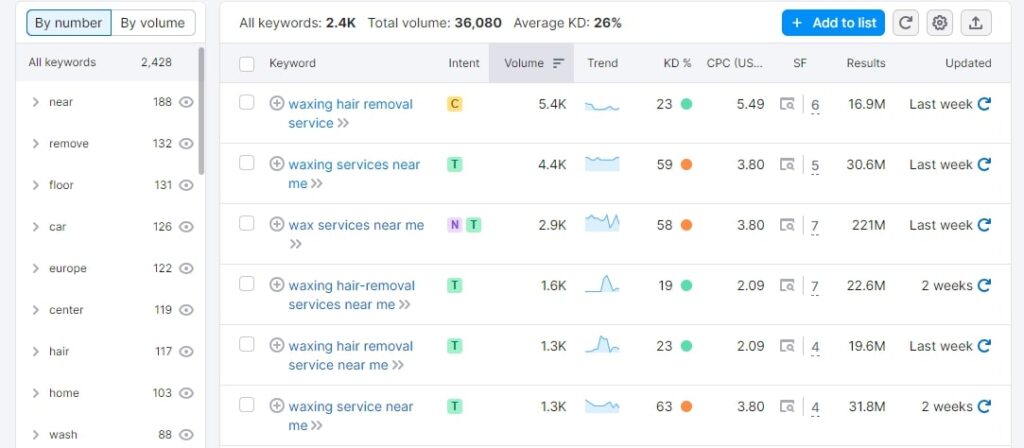
Understanding the words, phrases, and search terms your target audience uses enables you to tailor your content to meet their needs effectively.
You can enhance the effectiveness of your keywords by incorporating branded terms.
Instead of targeting generic phrases like “waxing at home benefits,” consider using branded keywords that include your brand or domain name (e.g., European wax center tips for waxing at home).
Branded keywords often yield multiple results from the same site in Google search results, enhancing your site’s visibility.
Utilizing branded thematic keywords provides a competitive advantage and serves as a powerful SEO technique.
Despite top brands dominating the top organic listings, leveraging branded thematic keywords can drive motivated visitors to your site.
In on-page optimization, avoid excessive repetition of primary keywords. Instead, incorporate synonyms or latent semantic indexing (LSI) terms.
LSI keywords help search engine algorithms extract meaning from keywords with multiple interpretations.
For instance, if you’re writing about the company Apple, using relevant terms associated with the organization improves the content’s context for search engines.
Overusing primary keywords (e.g., “used Apple Iphones”) may lead to over-optimization, potentially resulting in penalties from Google.
How to Avoid Google Penalties for Unnatural Links?
Backlinks play a crucial role in maintaining your site’s ranking position, making them an integral aspect of off-page SEO. However, it’s essential to address the issue of Google penalties and unnatural links in this context.
While links from high PR sites used to hold considerable weight, Google now prioritizes factors such as user intent and content relevance.
Although Google hasn’t provided a specific step-by-step guide for avoiding penalties, there are proactive measures you can take to minimize the risk of penalization and safeguard your site’s SEO integrity.
Create and Optimize Content For User
Ensuring that your content resonates with users should be your primary focus. This involves going beyond keyword density and considering the natural flow of your content.
User-centricity extends beyond keyword optimization. It encompasses providing valuable content that isn’t overly promotional.
Incorporating data and visuals into your posts can enhance their value and clarity, fostering engagement and trust with your audience.
When users find value in your content, they’re more likely to engage further with your brand.
Implement Anchor Text Diversification Strategies
After analyzing your backlink profile, it’s essential to diversify your anchor texts to maintain a natural link profile.
Diversifying anchor texts involves using a variety of keyword phrases, brand names, and generic terms. This approach signals to search engines like Google that your link profile is organic and not manipulative.
Relevance should guide your anchor text diversification efforts. Google evaluates links based on the thematic consistency between the referring and linked pages.
While you can’t always control the anchor texts used by external sites, prioritizing your brand name as anchor text can help maintain thematic relevance.
For instance, if you’re featured in an unrelated niche publication, using your brand name as anchor text is preferable.
Additionally, focus on acquiring links from high-quality websites, disavowing low-quality links, integrating no-follow links into your profile for a natural link distribution, and consistently publishing fresh content to increase brand visibility and mentions.
Conclusion
As demonstrated, off-page SEO complements on-page SEO and plays a crucial role in enhancing overall search engine optimization efforts. It’s imperative to strike a balance between optimizing your website internally and focusing on external factors. Prioritize activities such as proper link building, brand building, and effective social media engagement to maximize the impact of your SEO endeavors.
Remember that Google’s algorithm updates, such as Penguin, emphasize the importance of quality over quantity when it comes to incoming links.
Therefore, prioritize employing white-hat link building strategies to enhance your off-page optimization efforts.
Additionally, ensure that your website is well-prepared to receive authority link juice as you actively work on building and earning links.
This includes optimizing your site’s navigation for ease of use and accessibility.
I believe you found this guide to off-page SEO insightful and informative.
Now, I invite you to share your thoughts. Which tip discussed in today’s guide resonates with you the most? Feel free to share your feedback by leaving a comment below. Your insights are valuable to us!

